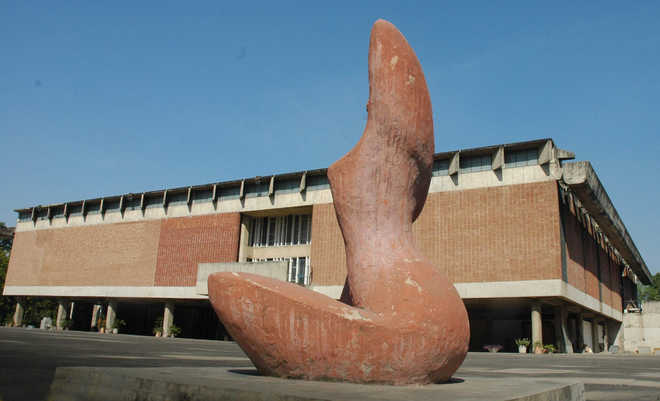It’s an art...
Amarjot Kaur
In 1929, Le Corbusier designed a model of the ‘Museum of Unlimited Growth’ (Musée à croissance illimitée) for the Mundaneum in Geneva but it could not be realised. Later, his idea of a museum building that could be expanded, as its collection grew, spelled itself in only three versions of Corbusian museums: Sanskar Kendra (in 1957, Ahmedabad), The National Museum of Western Art (in 1959, Tokyo) and Government Museum and Art Gallery (in 1965, Chandigarh).
On May 6, 1968, the Government Museum and Art Gallery flung its doors open to a well-planned city that didn’t quite have a culture of its own. It had acquired an envious collection of Gandhara art and miniature pahari paintings from the Central Museum at Lahore and flaunted it at a facade, which in itself is a work of art. Fifty years on, much has changed. The art gallery at the museum has been bustling with activity almost every month, the auditorium hosts a series of lectures by eminent artistes to foster cultural exchange, and the museum moved on from the Light and Sound Show to audio tours now. There always is, however, scope for improvement and city-based culture enthusiasts, who have been taking continuous initiatives to whet the city’s appetite for creative perspective, talk about where our city museum stands as far as global museology trends are concerned.
Of sarkar & its babus
A writer, art historian and member of Chandigarh Heritage Committee, BN Goswamy, feels, The Government Museum and Art Gallery should ideally be renamed as ‘The Chandigarh Museum’. In an e-mail interview, he writes: Without doubt the Museum is well-maintained and without doubt it has curatorial and other supporting staff, which has both energy and ideas. But it needs far greater support than it is getting from the sarkar. One is aware of the number of meetings of committees which have thoughtfully suggested changes to be made - in respect of interior design, for instance, changing the landscape and the environment around it, adding to its activities, enlarging its reach, among other things - and decisions on those matters have been recorded. But what is missing is the implementation of those decisions. With funds that have remained frozen, with directors changing every other year or so, with no meetings of the advisory committee having been held for years, and no additions to the collections made, clearly things can obviously not move.
Strong online presence
“We need to aggressively promote the Art Museum. Tourists, especially international ones, look for details on cultural activities on social media. We must have a strong online presence,” opines Deepika Gandhi, director at Le Corbusier Centre, Chandigarh, and Chandigarh Architecture Museum.
Deepika suggests that the reserve collection could be exhibited occasionally. “We can also do with a souvenir shop and a coffee-table book that weaves a narrative of all art in the museum. We need a cafeteria too,” she says. It is important to note that some five years ago the museum did start a cafeteria on the roof of Chandigarh Architecture Museum, which is located on its premises, but it was shut down soon after. “We are planning to float an expression of interest to run the Architecture Museum cafeteria,” says Deepika, as she doles out her last tip, “The Textile section on ground-floor could be used for exhibiting art. Also, we need to tie up with international organisations, like International Council of Museums (ICOM).”
Let’s exchange artworks
Rajnish Wattas, former principal of Chandigarh College of Architecture, who is also the member of Chandigarh Heritage Committee, says, “A museum should be visitor-friendly, not a sangrahalaya for storing art. We can also do with a digital information kiosk at the entrance of museum.” Wattas believes that one must bring the museum to people by conducting museum events and slideshows at Neelam, or Elante, or places that are frequented by people, to generate their interest in art. “Also, big museums, like Louvre, loan their artworks to other museums. We must follow suit and exchange art for art with other museums. Besides, the press building could be used for cultural events or office space. We could stack Corbusier-designed manholes there and auction them too, since most of them are being stolen anyway,” he suggests.
Working-class heroes
Medhavi Gandhi is the founder of Heritage Labs, which is an initiative that works across heritage, galleries, archives, museums, cultural, creative and education sectors to make them fun and accessible for all. She says, “The museum needs good programming line-up for people of all age-groups. It should remain open for longer hours, so that young professionals can drop in too. Also, it can also do with an internship programme. I feel a lot of young people would love the experience of working at the museum.”
Museum, as a muse
The Museum Building is nestled in the Leisure Valley of Chandigarh that was envisioned by Corbusier as the Cultural belt of the city. Along with the Chandigarh Architecture Museum and the Museum of Evolution of Life, it forms a unique complex of architectural and intellectual significance. The Government College of Arts building, conceptualised by Corbusier himself, is also very appropriately situated within the campus.
That’s how they do it in UK
Shriya Gautam, who runs an initiative called Speaking Archeologically, an archaeological education group, which focuses on object analysis and rescue archaeology, tells us about the museum culture in the UK: “So, coming from England, where museum-going is not just limited to students of art history but is extended to general activities. I personally believe that a more interactive platform is necessary to engage people of all ages, especially children. Textile sections for example have a dress-up activity for the kids. Similarly, there are various artefacts handling sessions in the museums, such as the British Museum, where every section has a special team of curators that help people understand objects by making them handle it.”
amarjot@tribunemail.com









